Index
- Activities and Initiatives by Country and Region
- Priorities for Action 1: Understanding Disaster Risks
- Priorities for Action 2: Strengthening Disaster Risk Governance to Manage Disaster Risk
- Priorities for Action 3: Investing in Disaster Risk Reduction for Resilience
- Priorities for Action 4: Enhancing Disaster Preparedness for Effective Response and to "Build Back Better" in Recovery Rehabilitation and Reconstruction
You can find "Project Report" from JICA library website, please access and search from the links provided.
Activities and Initiatives by Country and Region
JICA's Cooperation on Disaster Risk Reduction 1990s-Up to Now
Disseminating Japanese past-disaster lessons and experience to the world
Priorities for Action 1: Understanding Disaster Risks
Scientific technology needs to provide a reliable risk assessment based on scientifically analysed data to plan effective disaster countermeasures. Japan maintains and utilizes every type of disaster statistical data. The government closely works with the Science Council of Japan in the Central Disaster Management Council and also promotes evacuation training and disaster risk reduction education with local communities. Based on the experiences in Japan, JICA helps promote "understanding disaster risks."
Disaster Risk Reduction Planning Based on Scientific Risk Assessment
Nepal "Project for Assessment of Earthquake Disaster Risk for the Kathmandu Valley"
Earthquakes had repeatedly struck Kathmandu Valley in the past. There were hardly no regulations on the construction of earthquake resistant structures, or restrictions on land usage or buildings by then. The 7.8 magnitude earthquake that hit Nepal in 2015 caused tremendous damage to the country and the surrounding areas. It killed 8,790 people, injured 22,300, and destroyed 510,000 houses.
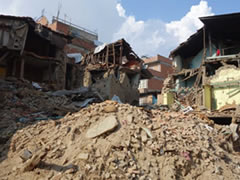
Damage in Nepal from the 2015 earthquake
The project for the assessment of earthquake disaster risk for Kathmandu Valley had carried out hazard assessment using the most advanced academic knowledge available and the risk assessment based on knowledge and damage estimates using multiple occurrence scenarios. The risk assessment results helped to organize the project models in the local government. Examples are the creation of local disaster risk reduction plans and earthquake resistance plans for public infrastructures.
* Newsletters of the Project for Assessment of EARTHQUAKE DISASTER RISK for the Kathmandu Valley in Nepal
Priorities for Action 2: Strengthening Disaster Risk Governance to Manage Disaster Risk
"Disaster Risk Reduction and Management" is a dual approach to a range of different measures for avoiding and reducing the risk of a disaster. In Japan, disaster countermeasures had relied on "public help" for a long time. The experience in the Great Hanshin-Awaji Earthquake and the Great East Japan Earthquake demonstrated the importance of improving "self-help" and "mutual help" during a large-scale disaster. Japan's "Disaster Countermeasures Basic Act" clearly states that disaster risks should be managed and reduced comprehensively through the vertical roles of the national and local governments, the horizontal role of society in the whole area, and collaboration with other stakeholders such as private sectors, NGOs and local communities. -The Sendai Framework for Disaster Risk Reduction views that "disaster risk governance" and the idea of "cooperation" is indispensable to build a disaster resilient social structure. The Sendai Framework also sets its priorities on "mainstreaming DRR," "disaster risk reduction plans and strategies" and "collaboration between government and multiple stakeholders." Legislations and standards have been developed and improved through history by experience. JICA will promote disaster risk governance by expounding on the importance of disaster risk reduction facilities, cooperation systems between related entities, and cooperation with those in the fields of science and technology.
Promotion of Mainstreaming DRR and Assessment of Underlying Risks
Sri Lanka "Disaster Management Capacity Enhancement Project Adaptable to Climate Change"
After the Sumatra earthquake and tsunami in December 2004, Sri Lanka established new institutions in national and local levels and has been improving its disaster countermeasures since then. JICA provided support for rehabilitation and reconstruction as well as support to further improve disaster risk reduction skills in the country.
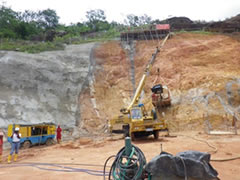
By providing high-precision elevation data, JICA assists in the drawing of hazard map of landslides and floods.
In this project, JICA provided technical and financial support to improve the skill of government agencies involved in important public infrastructure projects. JICA helped the National Building Research Organization to increase their ability to improve landslide disaster countermeasures. JICA also assisted in the disaster risk reduction system model covering evacuation and disaster risk reduction activities of the local residents.
As a result of this project, a disaster impact assessment method was developed and is now conducted prior to infrastructure development and maintenance in Sri Lanka. JICA also helped the Meteorological Agency improve their skills to monitor and forecast the weather efficiently and accurately. The Meteorological Agency used to take 50 minutes to collect data in the event of a disaster because the collected data was processed manually. Thanks to improvements in the information network, they are now able to collect observation data within 10 minutes. Their ability to announce warnings more quickly has contributed to reducing the damage.
The Ministry of Disaster Management of Sri Lanka and JICA made a Roadmap which, based on the main features of disasters, describes strategies and priority actions to effectively build a safe and resilient Sri Lanka in line with the Sendai Framework.
* Movies as output of the data collection survey in the Philippines may be accessed from the following sites:
Priorities for Action 3: Investing in Disaster Risk Reduction for Resilience
In the Sendai Framework for Disaster Risk Reduction Priorities Action 3, "Investing in Disaster Risk Reduction for Resilience", increasing the amount of investment in disaster risk reduction to reduce the risk of disasters is important, not only to protect human lives, but also for the surrounding environment, including assets and opportunities for development. As a country plagued by many disasters, Japan has been working on disaster preparation and JICA understands from experience that investment in disaster risk reduction is a necessary element for continuous growth. JICA utilizes the best Japanese technologies to reduce disaster risks such as setting standards based on risk assessment, establishing regulations on land use, and promoting suitable disaster risk prevention projects. JICA also promotes "mainstreaming DRR" in development and sector plans.
Risk-Resilient Critical Infrastructure
Thailand: "Subway that can operate in the event of a flood because of prior disaster management –Blue Line Subway in Bangkok"
Traffic congestion and air pollution in Bangkok, the capital of Thailand, have become a serious problem to development from the 1990's. The Blue Line Subway that opened in 2004 was designed with help from Japan to provide an alternative to road transportation, and the design includes many elements of disaster risk reduction. Since Bangkok is located in a flood-prone area, the subway entrance was made higher than the sidewalk. They also incorporated a structure that prevents water from getting into the station in the event of flood, and designed a structure that functions as a water shield at the subway entrance. Some of the vents were set at a higher position, and a drainage pump was installed. A guideline or procedures to close down the stations has been provided. A system is also in place for the safe operation of public transportation. At the time of the 2011 flood when airports and roads were closed, the Blue Line Subway continued to operate even in flooded areas without water getting into the subway stations. This public infrastructure maintenance project contributed not only to resolving environmental problems such as traffic jam and air pollution, but also showed a great example of mainstreaming DRR.
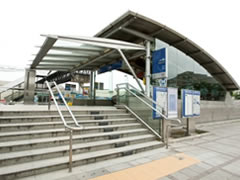
Flood Resistant Subway
Priorities for Action 4: Enhancing Disaster Preparedness for Effective Response and to "Build Back Better" in Recovery Rehabilitation and Reconstruction
To minimize damage and influence from disasters and to achieve early restoration and recovery, the following three actions are important: (1) Strengthen the preparation for emergency measures in advance; (2) Take action in forecasting disasters; and (3) Improve organizations and structures to respond effectively at all levels. Assuming that disasters will happen, Japan made preparations for various situations in advance. These include memorandums of agreement on disaster response between the national government, local authorities and the private sector. Japan has revised its systems and structures through lessons learnt from large-scale disasters, and aims to utilize limited funds. As the second best choice after an unfortunate and unavoidable disaster, Japan believes that it is necessary to carry out "Build Back Better." This approach will make a country more resilient and will prevent repeated damage from similar disasters. JICA helps disaster-affected countries achieve "Build Back Better" by promoting precautionary measures, and restoring and recovering from disasters.
Seamless Approach from Response to Development and "Build Back Better"
Philippines "The Project on Reconstruction and Recovery from Typhoon Yolanda"
Typhoon Yolanda hit the Philippines with a historically unprecedented scale on November 8, 2013 and inflicted extensive damage to a wide area of the country.
Soon after the disaster, the Government of Japan dispatched a Disaster Relief Medical Team and a team of experts which immediately conducted an investigation to assess the affected areas and a survey on the needs for recovery. The Government of Japan has seamlessly connected its emergency response to assistance activities in order to provide assistance in cooperation with grass-root communities. This includes grant aid projects, technical advices and JICA Partnership Programs. JICA encourages high ranking officials to intensively embrace the concept of "Build Back Better" for sustainable reconstruction from disasters.
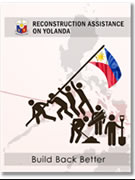
Concept of "Build Back Better" reconstruction assistance in Typhoon Yolanda
JICA projects are not just for recovery and reconstruction, but also help in the complete process of early recovery and reconstruction of affected areas. JICA projects help build disaster-resilient communities and society based on Japan's experience from the Great East Japan Earthquake in 2011. JICA encourages partnerships between autonomous bodies with cooperation of the related local governments. In addition, in drawing up the recovery and reconstruction plan, JICA strengthens partnerships among autonomous bodies with the cooperation of local governments. JICA also works on providing comprehensive recovery assistance such as measures to improve local people's income, encouraging the social participation of women.
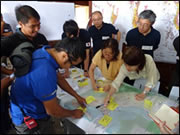
Local authority officials at a recovery planning workshop




scroll